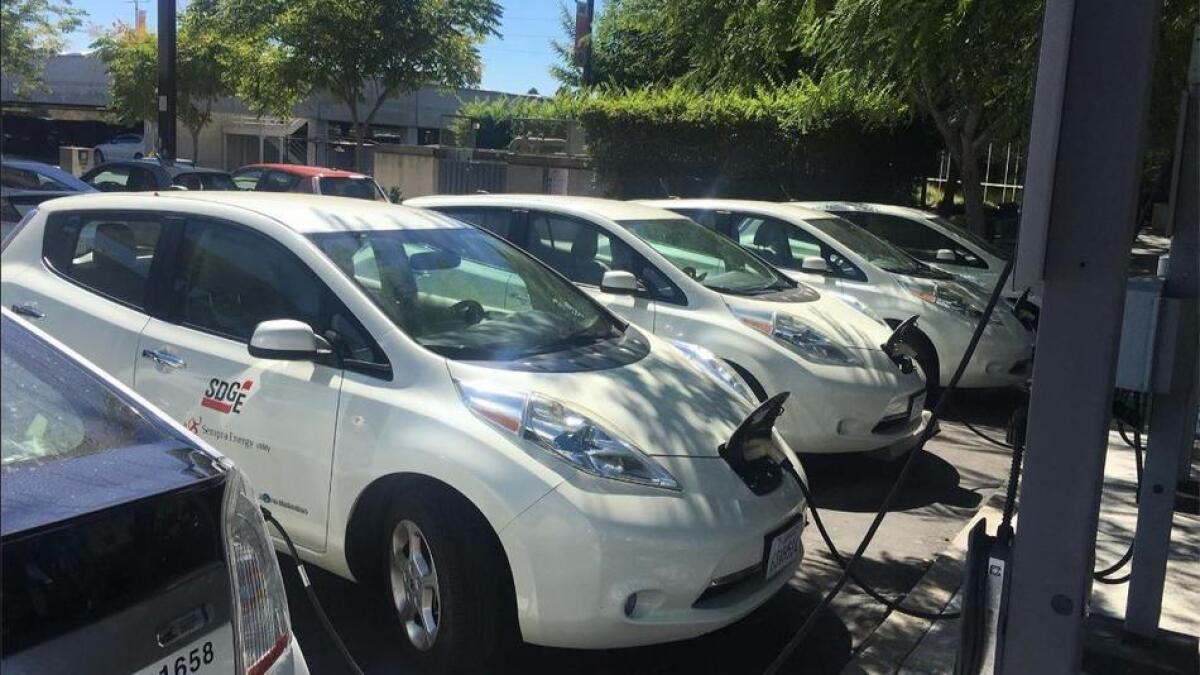California utilities propose a $1-billion electric vehicle push

Three of California’s largest utilities, including Southern California Edison, have put together proposals totaling more than $1 billion to try to electrify the state’s transportation sector.
The costs of the requests by Southern California Edison, Pacific Gas & Electric and SDG&E will be passed on to ratepayers and still need to be approved by the California Public Utilities Commission. The utilities say the projects will go a long way to reducing air pollution and greenhouse gas emissions.
Southern California Edison’s proposal is expected to cost $570 million, which will pay for electric vehicle incentives, rebates for residential charging stations and electrification projects for medium and heavy-duty vehicles.
Pacific Gas & Electric has requested $253 million, the bulk going to electric infrastructure aimed at larger vehicles such as buses that currently use diesel fuel. The PG&E proposal also wants to offer “a significant rebate” program for fast-chargers that can power electric vehicles in 20 or 30 minutes.
SDG&E wants to spend $244.1 million to install tens of thousands of charging stations in its service area to boost the transition to zero-emission vehicles, trucks, shuttles and delivery fleets.
Southern California Edison said the average residential customer could see a monthly bill increase of 53 cents a month — but about 29 cents for customers who meet income qualifications. PG&E customers would see a monthly bill increase of less than 28 cents. Typical residential SDG&E customers would see an increase of about 71 cents a month to their bills in 2020.
Officials at the Utility Reform Network, a consumer advocacy group that monitors the state’s utilities and the PUC, said the proposals represent “laudable goals” but the group doesn’t like the prospect of customers getting billed for projects that may not necessarily lead to “clear and direct benefits” to all ratepayers, especially in low-income communities.
Under provisions of SB350, utilities are required to detail how they plan to reduce greenhouse gas emissions and ramp up deployment of clean energy resources. Utilities are also authorized to “undertake transportation electrification activities.”
“The benefits of electric vehicles are growing,” said Ron Nichols, president of SCE, “but barriers to their adoption still exist — and utilities and other market participants have a clear role to play in overcoming those barriers.”
There are more than 265,000 vehicles classified by California government agencies as zero-emissions vehicles, by far the most of any state in the nation.
But sales for EVs and hybrids have remained flat across the state, largely because of the low price of oil, which has resulted in average gasoline prices in California dropping from more than $4 a gallon as late as July 2014 to $2.78 this week for a gallon of regular.
SIGN UP for the free California Inc. business newsletter »
“You can’t just slap a green label on something and thereby make it effective,” said Utility Reform Network spokeswoman Mindy Spatt. “What we want to see are effective programs that do provide benefits to customers, both environmental and financial. We can’t just throw money at the problem, especially when it’s customers’ money.”
Each of the utilities’ proposals will get vetted through the PUC’s regulatory process. The first round of decisions, focusing on the smaller aspects of the proposals, are not expected until later this year.
To read the article in Spanish, click here
MORE BUSINESS NEWS
Southern California Gas taps Aliso Canyon amid conservation warnings
Trump tells auto CEOs that environmental regulations are ‘out of control’
Tech workers aren’t known for political activism. But that may be changing
After years of record profits, airlines face turbulence in 2017. Could higher airfares follow?



